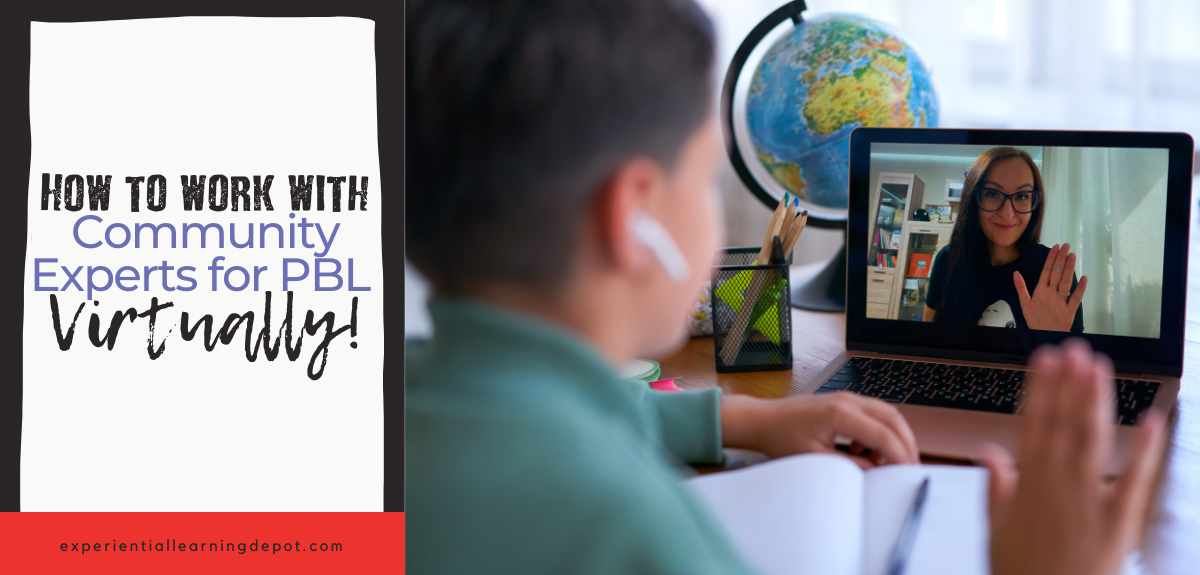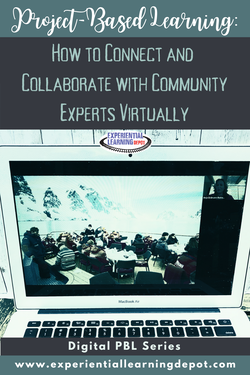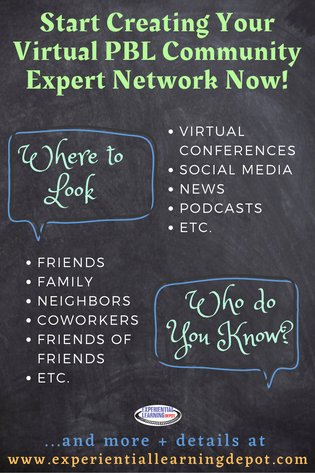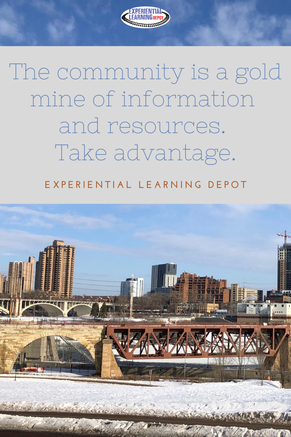|
Experiential learning resources for the innovative educator
The use of community experts is common place in project-based learning. But how do you communicate with and partner with community experts when you don't have the flexibility to leave the classroom or bring experts to you? Students do so virtually! There are some aspects of student-led project-based learning that can be daunting. Connecting and collaborating with community members has always been a struggle for some of my students, but working through that fear is a must for several reasons:
Students can utilize community experts in a variety of ways. They could use experts for information and guidance. They can partner and collaborate with community experts. They can even use the amazing resources and connections that community members have. But what if you don't have the flexibility to bring students out into the world to work in-person with experts? What if you have 25 students in your class each working on their own PBL with unique topics, and, therefore, unique experts? It would be difficult to get each student in-person with a different expert. What if you're working with younger children that don't have the means or independence to meet with experts outside of school after school hours? In other words, what if the circumstances of your schedule or student population make the use of community experts feel near impossible? With technology! We live in a digital era where communication is accessible and rapid. There are some pretty amazing ways for students to work with community experts virtually. Let's take a look. How to Work Virtually with Community Experts for Student-Led Project-Based Learning Experiences1. How to Gather Information from Community Experts Virtually: Students should use experts to gather information about their project topics. I am a biology teacher, but I am not an expert on colony collapse disorder, for example, a topic that came up during out pollinator study. The U of M had a CCD research program at the time. I was able to bring my students to their lab to discuss their research on disappearing bees. But how could students have gathered information from this expert team without being face-to-face?
2. How to Utilize Community Expert Resources Virtually: I have been able to get my hands on so many unique resources by connecting with the right people. My favorite of all time was a human brain. A neurology student conducting research and writing her dissertation on addiction came in to speak to my students and brought with her a real human brain. She then donated sheep brains for us to dissect. Although my neurology students worked with this expert face-to-face (she came to our classroom), we could have had a similar experience virtually. For example, she could have delivered sheep brains to the school or I could have picked them up and students could have dissected the brains with the expert on a Zoom call during the process. I have had many students publish guest blog posts on the websites of established bloggers. This is an example of using the resources (established blog) and connections of a community expert virtually. The students and the experts communicated about the guest post through email and phone. They also worked on drafts and editing virtually using Google Drive. The students write their articles in Google Docs and share the document with the blogger. 3. How to Collaborate with Community Experts Virtually: There are so many amazing online programs that offer sharing and collaborating capabilities. For example, let's say students are coordinating a fundraiser. Students collaborate with local chefs to create a cookbook filled with recipes using only local ingredients. They then sell the cookbook. Communication with experts can happen virtually through email, phone calls, Zoom calls, etc. Collaborating on a final product (such as a cookbook) can happen virtually as well, again through document sharing. Google Apps is great for this and so is Canva. The entire cookbook, for example, could be created by a variety of collaborators without anyone ever meeting face-to-face. That isn't necessarily ideal all the time, but again, if your options are limited, work with experts virtually. There is nothing wrong with it. It can be a powerful learning and skill-building experience. Start Building Your Network: Keep an eye out for awesome community experts, especially if you will be the one coordinating these collaborations. My students self-direct their PBL experiences, so they generally find their own experts, but it's nice for you to have a log of potential connections to offer your students if they need some guidance. Start with these steps: 1) Brain Dump: Grab a piece a paper, pull up a Google Doc or planning program, and dump all of your ideas for connections and collaborations into it.
2) Reach Out: Connect with someone of interest on LinkedIn, through email, or make a couple of phone calls. Just put your feelers out there. 3) Log Connections/Develop a Network: Jot down those that you make connections with or work with. Once you have worked with them, stay connected and keep them posted so that there is potential for future collaborations. What are some of your favorite ways to bring community collaborators into your curriculum? How about digitally? I am gradually learning about amazing educational technologies, but have a lot more to learn. Fill me in!
For more details, tips, tricks, and resources on community experts, head back to to some earlier blog posts. Try this post on using the community as a resource and keep checking back for more posts in my PBL digital series. Follow Experiential Learning Depot on Pinterest and Instagram for more on experiential education, and check out my TpT store for experiential learning resources. Observe. Question. Explore. Share.
2 Comments
8/9/2020 09:14:24 am
Exciting work,, Sara. I don't know if you are cataloging resources but if so I can be a resource on:
Reply
Sara
8/12/2020 08:07:00 am
Yes, Wayne! That is excellent. Thank you for offering your expertise!
Reply
Your comment will be posted after it is approved.
Leave a Reply. |
Blog IntentTo provide innovative educational resources for educators, parents, and students, that go beyond lecture and worksheets. AuthorSara Segar, experiential life-science educator and advisor, curriculum writer, and mother of two. Categories
All
|






 RSS Feed
RSS Feed